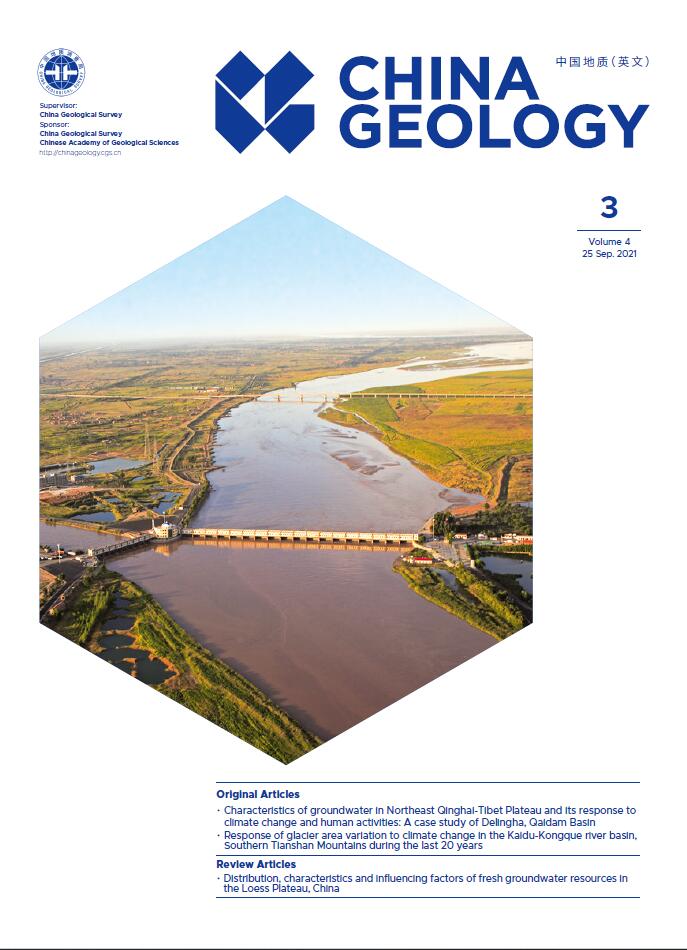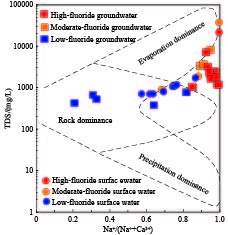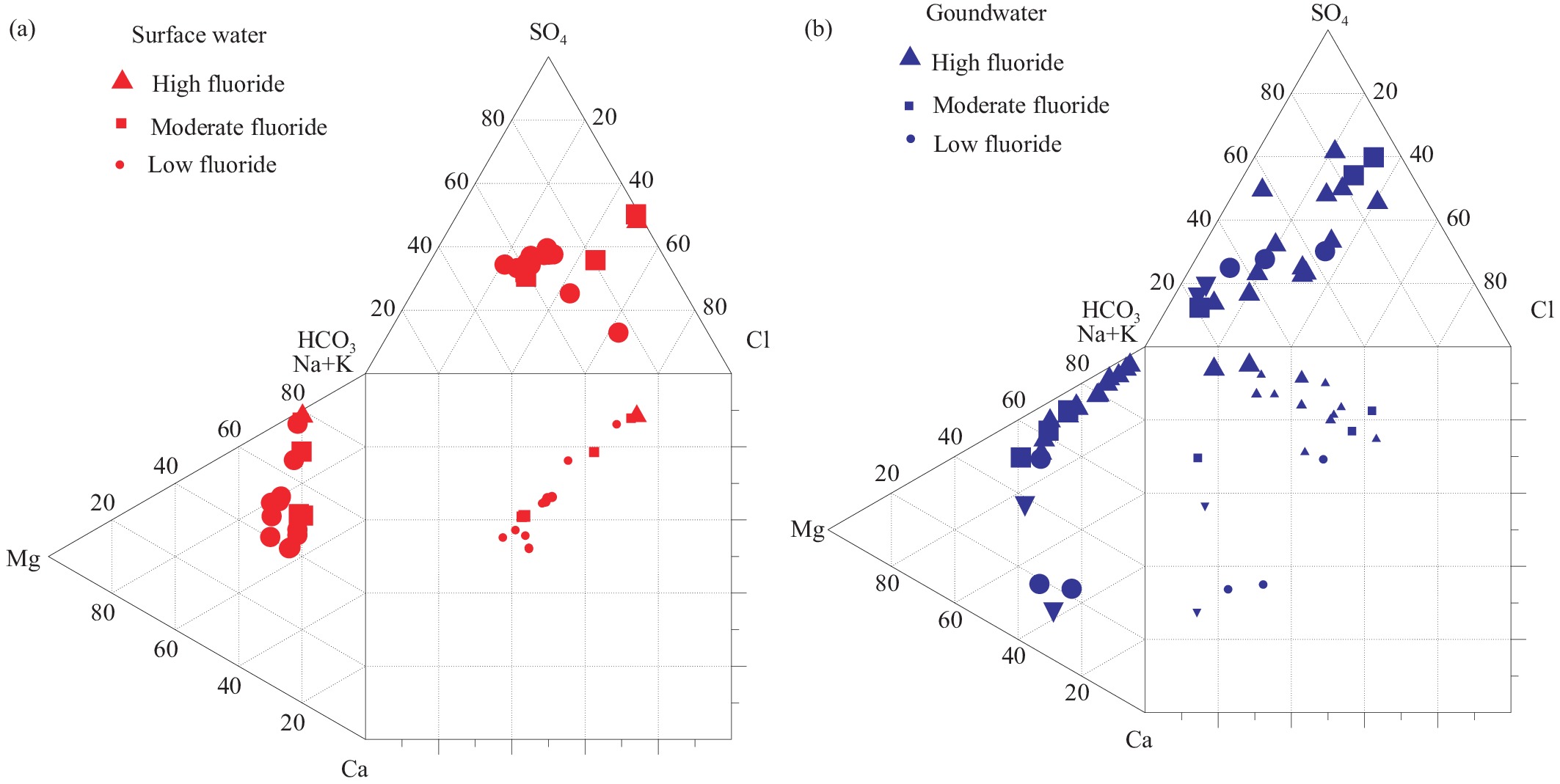| Citation: | Rui-ping Liu, Hua Zhu, Fei Liu, Ying Dong, Refaey M El-Wardany, 2021. Current situation and human health risk assessment of fluoride enrichment in groundwater in the Loess Plateau: A case study of Dali County, Shaanxi Province, China, China Geology, 4, 487-497. doi: 10.31035/cg2021051 |
Current situation and human health risk assessment of fluoride enrichment in groundwater in the Loess Plateau: A case study of Dali County, Shaanxi Province, China
-
Abstract
This study aims to investigate the mechanisms and health risks of fluoride enrichment in groundwater in the Loess Plateau, China. By taking Dali County, Shaanxi Province, China as an example, this study obtains the following results through field investigation and the analyses of water, soil, and crop samples. (1) The groundwater can be divided into two major types, namely the Quaternary pore-fissure water and Karst water. The Karst area and sandy area have high-quality groundwater and serve as the target areas for optional water supply. The groundwater in the study area is slightly alkaline and highly saline. Meanwhile, high-fluoride groundwater is mainly distributed in the loess and river alluvial plains in the depression area of the Guanzhong Basin and the discharge areas of the groundwater, with the highest fluoride concentration exceeding seven times the national standard. (2) Fluoride in groundwater mainly originates from a natural source and human activities. The natural source refers to the fluoride-bearing minerals in rocks and soil, and the fluoride from this source is mainly controlled by natural factors such as climate, geologic setting, pH, specific hydrochemical environment, ion exchange, and mineral saturation. Human activities in modern life can be further divided into industrial and agricultural sources primarily. (3) The health risks of fluoride contamination are very high in the Loess Plateau, especially for children compared to adults. Meanwhile, the risks of fluoride exposure through food intake are higher than those through drinking water intake. The authors suggest selecting target areas to improve water supply and ensure the safety of drinking water in the study area. Besides, it is necessary to plant crops with low fluoride content or cash crops and to conduct groundwater treatment to reduce the fluoride concentration in drinking water. These results will provide a theoretical basis for safe water supply in the faulted basin areas in the Loess Plateau.
-
Keywords:
- Fluoride /
- Groundwater /
- Human health risks /
- Loess Plateau /
- Hydrogeological survey engineering /
- Dali County /
- Shaanxi Province /
- China
-

-
References
Ali S, Thakur SK, Sarkar A, Shekhar S. 2016. Worldwide contamination of water by fluoride. Environmental Chemistry Letters, 14(3), 291–315. doi: 10.1007/s10311-016-0563-5. Borgnino L, Garcia MG, Bia G, Stupar YV, Le Coustumer P, Depetris PJ. 2013. Mechanisms of fluoride release in sediments of Argentina’s central region. Science of the Total Environment, 443, 245–255. doi: 10.1016/j.scitotenv.2012.10.093. Chidambaram S, Sarathidasan J, Srinivasamoorthy K, Thivya C, Thilagavathi R, Prasanna MV, Singaraja C, Nepolian M. 2018. Assessment of hydrogeochemical status of groundwater in a coastal region of Southeast coast of India. Applied Water Science, 8(1), 1–11. doi: 10.1007/s13201-018-0649-2. Chinese Nutrition Society. 2011. Dietary guidelines for Chinese residents, Ministry of Health, PRC. https://www.jianshu.com/p/e1aedf9b7366 (in Chinese). Centers for Disease Control and Prevention. 2005. Limit of pollutants in food (GB 2762-2005). Ministry of Health, PRC, 1‒11 (in Chinese). Fan JJ, Tong YQ, Li JY, Wang LX, Li R, LIU ZY. 2008. Affecting factors of high-fluorine water in our country and scheme to avoid fluorosis. Safety and Environmental Engineering, 15(1), 14–16 (in Chinese with English abstract). Hui Q, Jie C, Ken WFH. 2020. Assessing groundwater pollution and potential remediation processes in a multi-layer aquifer system. Environmental Pollution, 263, 114669. doi: 10.1016/j.envpol.2020.114669. Li PY, Qian H, Wu JH. 2014. Accelerate research on land creation. Nature, 510(7503), 29–31. doi: 10.1038/510029a. Li PY, Qian H, Wu JH. 2018. Conjunctive use of groundwater-surface water to reduce soil salinization in the Yinchuan Plain, northwest China. International Journal of Water Resources Development, (34), 337–353. doi: 10.1080/07900627.2018.1443059. Li PY, Tian R, Liu R. 2018. Solute geochemistry and multivariate analysis of water quality in the Guohua Phosphorite Mine, Guizhou Province, China. Exposure and Health, 11(2), 81–94. doi: 10.1007/s12403-018-0277-y. Liu RP, Zhu H,Liu JX,Jiao JG,Yang BC, Qiao G, Zhao AN. 2009a. The hydrogeochemistry Regulation of the groundwater on fluoride in the Dali Area, Guanzhong Basin. Hydrogeology & engineering geology, (5), P84–88,93 (in Chinese with English abstract). Liu RP, Zhu H, Yang BC, Zhao AN, Ke HL, Qiao G. 2009b. Occurrence Pattern and Hydrochemistry Cause of The Shallow Groundwater Fluoride in the Dali County, Shaanxi Province. 42(2), 116-125 (in Chinese with English abstract). Narsimha A, Rajitha S. 2018. Spatial distribution and seasonal variation in fluoride enrichment in groundwater and its associated human health risk assessment in Telangana State, South India. Human and Ecological Risk, 4(8), 2119–2132. doi: 10.1080/10807039.2018.1438176. Singh CK, Kumari R, Singh N, Mallick J, Mukherjee S. 2013. Fluoride enrichment in aquifers of the Thar Desert: Controlling factors and its geochemical modeling. Hydrological Processes, 27(17), 2462–2474. doi: 10.1002/hyp.9247. Subba RN. 2017. Controlling factors of fluoride in groundwater in a part of South India. Arabian Journal of Geosciences, 10, 524. doi: 10.1007/s12517-017-3291-7. Wei C, Guo H, Zhang D, Wu Y, Han S, An Y, Zhang F. 2016. Occurrence and hydrogeochemical characteristics of high fluoride groundwater in Xiji County, southern part of Ningxia Province, China. Environmental Geochemistry and Health, 38, 275–290. doi: 10.1007/s10653-015-9716-x. WHO. 2017. Guidelines for drinking water quality: The fourth edition incorporating the first addendum. 1–564. http://apps.who.int/iris/bitstream/handle/10665/44584/9789241548151_eng.pdf;sequence=1 Xiao J, Jin Z, Zhang F. 2015. Geochemical controls on fluoride concentrations in natural waters from the middle Loess Plateau, China. Journal Geochemical Exploration, 159, 252–261. doi: 10.1016/j.gexplo.2015.09.018. Zhang MS, Liu J. 2010. Controlling factors of loess landslide in Western China. Environmental Earth Sciences, 59(8), 1671–1680. doi: 10.1007/s12665-009-0149-7. -
Access History

-
Figure 1.
Spatial distribution of fluoride in groundwater. a–spatial distribution of fluoride in groundwater in Dali Country; b–Geographic location of Guanzhong basin in the eastern hemisphere; c–Geomorphological map of loess plateau (Zhang MS and Liu J, 2010); d–spatial distribution of fluoride in groundwater in the Guanzhong Basin.
-
Figure 2.
Gibbs diagram showing the control mechanisms of natural water chemistry.
-
Figure 3.
Piper diagram showing the hydrochemical characteristics of natural water.
-
Figure 5.
Relationships between F− and saturation indices of calcite, dolomite, gypsum, and fluorite.
-
Figure 4.
Bivariate plots showing ion exchange (a) and its impacts on fluoride enrichment (b).
-
Figure 6.
Comparison of health risks of fluoride through different intake ways.





 DownLoad:
DownLoad:




